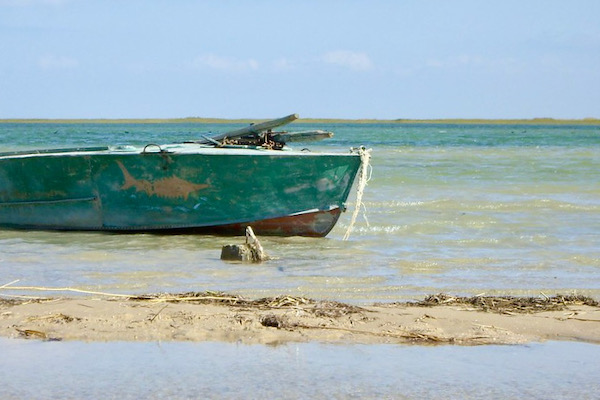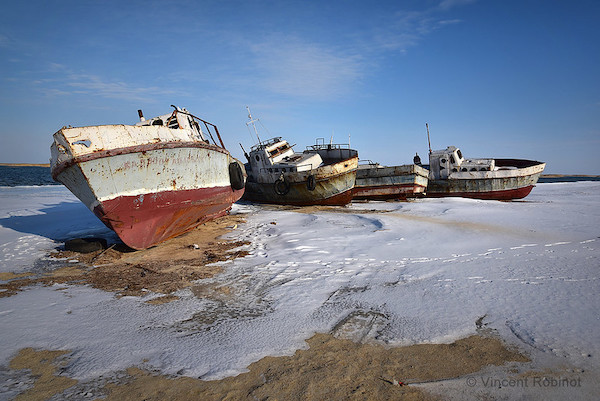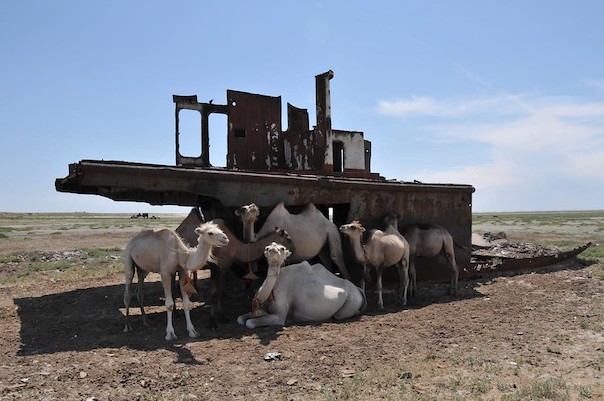KAZAKHSTAN
The Vanishing Sea
By Jenny McGlone
Chapel Hill, NC, United States
These days, you would be hard pressed to find someone who hasn’t heard of or experienced climate change. The implications of this global phenomenon seem to be as ominous as they are widespread. It’s easy to feel helpless when confronted with the impact of this increase in average temperatures across the planet.
But what if it were possible to reverse a large-scale environmental disaster? Would that give us hope? Just such a recovery has already taken place in Central Asia. Let’s begin with some history.
Beginnings
One hundred years ago, the fourth largest inland lake in the world was located in Russia, between what is now the southern part of Kazakhstan and northern Uzbekistan. Geologists estimate that the Aral Sea formed about 5.5 million years ago, fed by the Syr Darya river to the north and Amu Darya river to the south. It covered 28,000 square miles and contained a mild 10 grams of salt per liter (g/L).
By the mid-twentieth century, the fishing industry of the Aral Sea supported thousands of families in 19 villages and two cities. More than 40,000 tons of fish each year were processed by canneries and transported by train to surrounding regions.
Irrigation Problems
In addition to the thriving human population, the Aral Sea also contained numerous species of fish, birds, and other wildlife. This healthy ecosystem was placed in jeopardy in 1918, when authorities in the former Soviet Union decided to divert water from the Syr Darya and Amu Darya to irrigate nearby deserts. They envisioned creating an agricultural economy of wheat, rice, melons, and cotton, all profitable but thirsty crops.
By the 1960s, the number of cultivated acres had risen from 6.4 to 15.9 million. Unfortunately, with its two major inflows redirected, the Aral Sea began to shrink.
Consequences
From 1961 to 1970, the Aral Sea’s depth fell an average of 20 centimeters per year. In the following decade, the rate sped up to 50 to 60 centimeters per year. As the lake continued to disappear, more water was taken for irrigation, with the amount doubling from 1960 to 2000. Despite 30 to 75 percent of the water being lost to leakage or evaporation, Uzbekistan became the world’s largest exporter of cotton in 1988. The cost of this agricultural success was that the Aral Sea forfeited nine-tenths of its original volume.
The Amu Darya, the sea’s primary source, now ends 70 miles short of the lakeshore, with rain and groundwater unable to make up the shortfall. With an increase in salinity to 30 g/L, many native fish species either dramatically decreased in numbers or disappeared altogether. Over 60,000 jobs were lost.

Divided Sea
As the water receded, the lake split into two sections in 1986. Five years later, the Soviet Union collapsed. In order to address the plague of dust storms, summer heat, and health ailments in areas around the sea, a newly independent Kazakhstan permitted the construction of a dam to preserve the entirety of the Syr Darya’s inflow for the northern half of the lake. By 2005, the World Bank and national government were persuaded to contribute US$85 million for an eight-mile dam and improvements to irrigation canals.
Reversal
Scientists predicted that the water level would not reach the top of the new dam for five years. Instead, in a stunning victory for Mother Nature, water was spilling over the dam in eight months. The Northern Aral has regained about 5 percent of its original water surface. Currently, the extent of sea coverage is 33 percent of what it was in 1960.

With improved salinity, fishing communities have learned sustainable resource management. They collaborate with scientists and governmental agencies to implement new practices. The Aral Sea’s prospects serve as an example to us that sometimes it’s better to go with the flow than to throw in the towel.
Have a suggestion for this story? We’d love for you to submit it!


Blank
Blank
Math Resources
1. Our story says that 40,000 tons of fish were processed each year by canneries around the Aral Sea. Let’s figure out what this means.
- If a good-sized can of fish weighs one pound, how many cans are produced in one year?
- If one can of fish can feed one person each day, for how long can a family of four eat from a stockpile of 50 cans?
- How long would a city of 1,000 residents be able to eat if it had 20,000 cans in reserve?
2. If scientists predicted that it would take five years for the lake to refill, and instead it took eight months, how do you express that change in a percentage?
3. Devise a table that charts the change in salinity every 10 years from 1900 to 2000 if it began at 10 g/L and finished at 30 g/L.
Social Justice Questions
- How do you feel about the role that the agricultural industry played in the loss of the Aral Sea? Do you think those companies that profited from the irrigation should compensate the fishermen who lost their jobs?
- What would you like to see happen in the future to protect the environmental progress that has been made?
Explore Further
- News story with satellite images of the disappearing sea
- Human environmental impact on the Aral Sea
- Comparison between Kazakhstan and Uzbekistan
- News video on the history and recovery
- Recovery of the fishing industry
Share Your Story
Write your own Global Math Story and send it to us!
Sorry, the comment form is closed at this time.